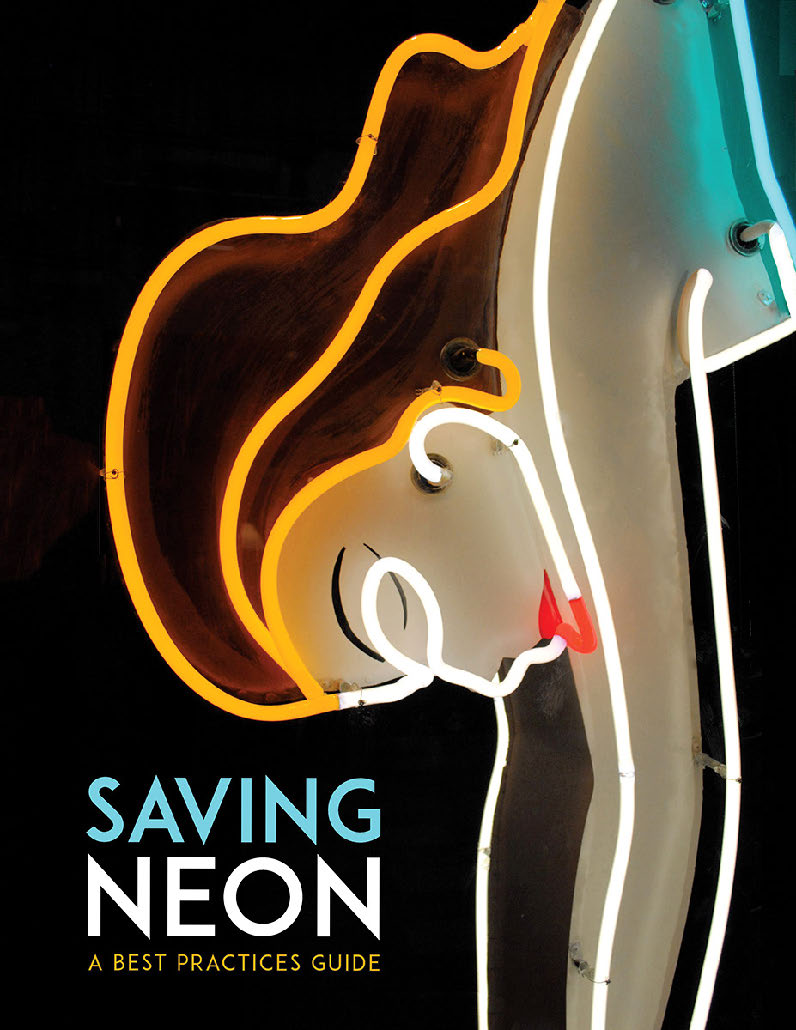Saving Neon: A Best Practices Guide
By Al Barna and Randall Ann Homan
San Francisco: Giant Orange Press/San Francisco Neon, 2018
Magazine format, 40 pages, $20
Available at neonspeaks.org
Reviewed by Paul Sherman
 If you’re reading this, chances are, at some point, you have passed a stylish neon sign battered by age and the elements and thought, “Someone ought to bring that sign back to its original glory.” Like most of us, though, you might have no idea how actually to do so. There are the costs, the physical logistics and the simple nuts and bolts of how to repair the neon lighting, painted metal base, and electrical wiring.
If you’re reading this, chances are, at some point, you have passed a stylish neon sign battered by age and the elements and thought, “Someone ought to bring that sign back to its original glory.” Like most of us, though, you might have no idea how actually to do so. There are the costs, the physical logistics and the simple nuts and bolts of how to repair the neon lighting, painted metal base, and electrical wiring.
Enter Al Barna and Randall Ann Homan’s Saving Neon: A Best Practices Guide. A handsome, full-color volume that is about the same size and length as this magazine, Saving Neon is a spiffy how-to manual that could just help to turn your (OK, somebody’s) quixotic dream of neon resurrection into reality. Made with input from the neon-restoration community, including some names familiar to SCA members such as Debra Jane Seltzer, Tod Swormstedt, Heather David, Len Davidson, and Robert Gehl, Saving Neon fulfills its mission to be “a crash course on saving a neon sign” in inspiring fashion.
The book combines lofty principles and mundane, if no less fascinating, logistics. The introduction by Los Angeles neon restorers Dydia DeLyser and Paul Greenstein address the principles inherent in neon restoration. Not only do they distinguish among restoration, which returns something to its original state; preservation, which retains evidence of age and wear; and adaptive reuse, which puts a restored sign in a new context: their introduction also declares restoration as the best practice for outdoor neon signs—keeping them in their original place and returning them to their original condition.
Manifesto thus established, the rest of Saving Neon covers the logistics. The authors handle much of that in a helpful FAQ format, answering a pair of related questions covering such topics as paint color, tube bending, wiring & transformers, and metal cabinets & pigeons (pigeon detritus is, with elegance and understatement, referred to as a “common accelerant” of rust and rot here). If you’ve ever wondered how putting any of the five noble gases in a glass tube can create colored light, that information is here, too. Several illustrative photos always accompany the responses to these questions, allowing Saving Neon to show readers how things are done, not just tell them.
Such how-to basics also hold to principles similar to those espoused in the introduction. Despite the inroads that LED tubing has made as a replacement for neon, Saving Neon makes another declaration by proclaiming that such a substitution is “just, well, wrong” for several reasons (though replacing neon-accompanying, energy-intensive incandescent bulbs with more efficient LED bulbs is OK). Once again, we have a blend of the practical and the idealistic here.
Not surprisingly, Saving Neon highlights a handful of successful restorations in a section called “Success Stories.” Less expected, and just as instructional, is another section called “Lessons Learned” that offers another handful of restorations, most of these poorly conceived, usually involving the removal of both neon and the artistic flair of original lettering.
All in all, this is impressive work by experts, writing for a non-expert readership.
This book review originally appeared in the SCA Journal, Fall 2019, Vol. 37, No. 2. The SCA Journal is a semi-annual publication and a member benefit of the Society for Commercial Archeology.
More Book Reviews

